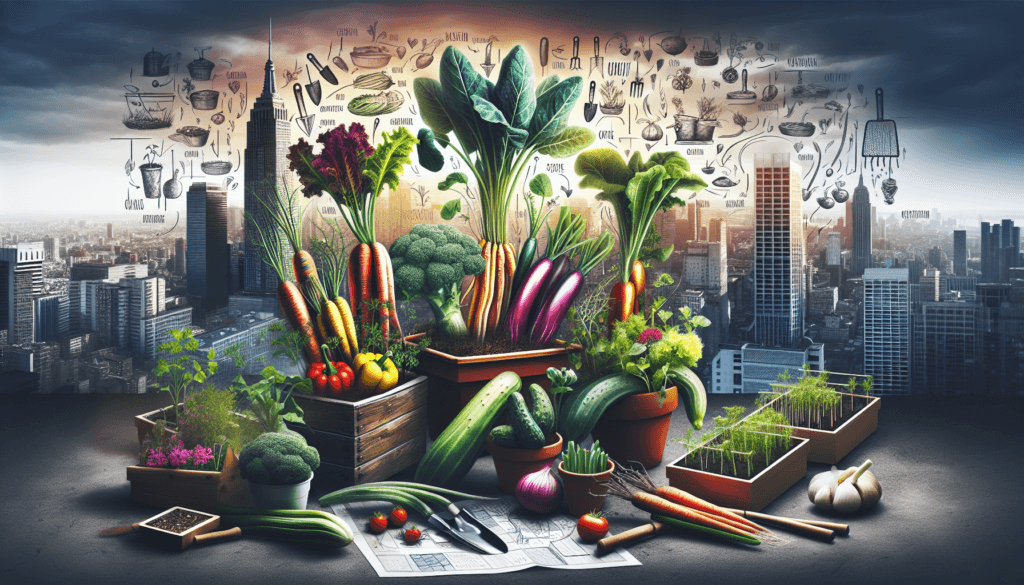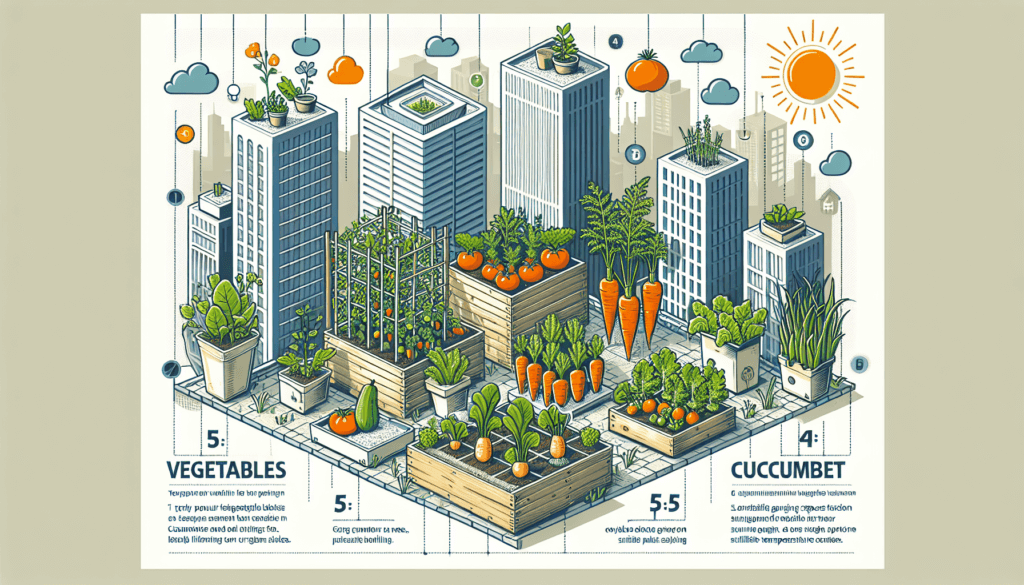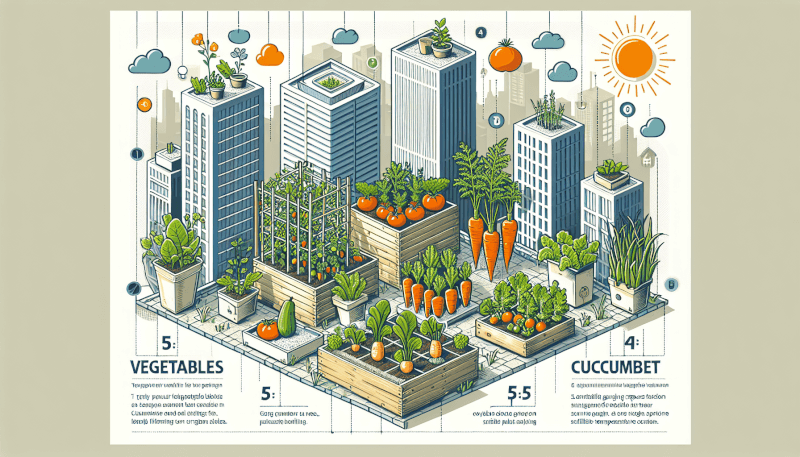Are you interested in starting your own urban garden but unsure where to begin? Look no further! In this article, we will introduce you to the top five most popular vegetables for urban gardening. These vegetables are easy to grow, versatile in their uses, and perfect for those with limited space. From juicy tomatoes to crisp lettuce, you will discover the perfect vegetables to kickstart your urban garden and reap the bountiful rewards of homegrown produce. So grab your gardening gloves and get ready to embark on a green adventure!

Tomatoes
Overview
Tomatoes are one of the most popular vegetables for urban gardening. They are not only delicious but also relatively easy to grow in containers or small spaces. Whether you have a balcony, rooftop, or just a small patio, you can enjoy the taste of homegrown tomatoes. With a wide range of varieties available, you can choose the ones that suit your taste and gardening space.
Best Varieties for Urban Gardening
When it comes to tomatoes, there are countless varieties to choose from. However, some are better suited for urban gardening than others. Determinate varieties like ‘Roma,’ ‘Celebrity,’ and ‘Patio Princess’ are great choices as they have a more compact growth habit and can be grown in smaller containers. Cherry tomatoes like ‘Sweet 100’ and ‘Sun Gold’ are also popular for urban gardens due to their small size and abundant fruit production.
Container Gardening Tips
Growing tomatoes in containers requires some careful considerations. First, choose a large enough container with good drainage to accommodate the roots and prevent waterlogging. Use high-quality potting soil mixed with compost for better fertility. Place the containers in a sunny spot, preferably getting at least 6-8 hours of direct sunlight daily. Regularly water the plants, ensuring the soil is consistently moist but not waterlogged. You can also stake or provide support for taller varieties to prevent them from toppling over.
Pest and Disease Control
Tomatoes can be prone to pests and diseases, but with proper care, you can minimize the risk. Aphids, tomato hornworms, and whiteflies are common pests that can damage your plants. Regularly inspect the leaves and stems, and if you notice any pests, you can use organic insecticidal soaps or natural predators like ladybugs to control them. Diseases like early blight and powdery mildew can also affect tomatoes. To prevent these, ensure good air circulation, avoid overhead watering, and remove any infected leaves promptly.
Harvesting and Storing Tomatoes
The joy of growing tomatoes is in harvesting and enjoying the fruits of your labor. As the tomatoes ripen, gently pluck them from the vine, making sure to leave the calyx (the green part that attaches the fruit to the stem) intact. It’s best to harvest when the tomatoes are fully mature and have reached their desired color. Store ripe tomatoes at room temperature and away from direct sunlight for the best flavor. If you have an abundance of tomatoes, consider canning, freezing, or making delicious sauces to enjoy throughout the year.
Lettuce
Overview
Lettuce is another fantastic vegetable for urban gardening, especially for those who love fresh salads and greens. It is a cool-season crop that can easily thrive in containers or limited spaces, making it an ideal choice for urban dwellers with a green thumb. With a variety of leaf types and colors, growing lettuce can add a vibrant and edible touch to your urban garden.
Best Varieties for Urban Gardening
Different lettuce varieties offer various characteristics, from crisp and sweet to tender and buttery. For urban gardening, loose-leaf varieties such as ‘Salad Bowl,’ ‘Black Seeded Simpson,’ and ‘Red Sails’ are excellent choices. These varieties are quick to mature, allowing you to enjoy multiple harvests throughout the growing season. They are also more forgiving in terms of space requirements and can be grown in containers, window boxes, or even hanging baskets.
Growing Lettuce in Limited Space
Since lettuce doesn’t require extensive root space, it can be easily grown in limited areas. Select a container that is at least 6-8 inches deep and has good drainage holes. Use loose and well-draining potting soil enriched with organic matter to ensure healthy growth. Lettuce thrives in cool temperatures, so it is best to sow the seeds in early spring or early fall to avoid extreme heat. Regularly water the plants to keep the soil consistently moist, especially in warmer weather.
Watering and Fertilizing
Lettuce prefers evenly moist soil, so it’s crucial to water them regularly, especially during hot and dry periods. However, avoid overwatering, as it can lead to the development of diseases like rot or fungal infections. Consider using drip irrigation or a watering can with a fine spray attachment to deliver water directly to the soil without wetting the leaves. Lettuce is generally a light feeder, so a balanced organic fertilizer applied every few weeks or following the package instructions can provide the necessary nutrients.
Harvesting and Enjoying Fresh Lettuce
One of the greatest rewards of growing lettuce is being able to harvest and enjoy fresh, crispy leaves straight from your garden. Harvesting can be done at different stages depending on your preference. For baby lettuce, you can start harvesting when the leaves are around 2-3 inches long. For mature lettuce, wait until the outer leaves reach full size but before they start turning yellow or bolting. Harvest by cutting the leaves close to the base, leaving about an inch for regrowth. Rinse the leaves well, and you’re ready to create delicious salads or add fresh greens to your favorite dishes.

Peppers
Overview
Peppers are a versatile vegetable that brings a burst of flavor and color to any urban garden. With their vibrant hues, ranging from green and yellow to red and purple, peppers not only look beautiful but also add a spicy or sweet kick to your meals. Whether you prefer bell peppers or hot chili peppers, growing them in containers or limited spaces is an achievable feat.
Best Varieties for Urban Gardening
When it comes to peppers, there are plenty of options to suit your taste and gardening space. For bell peppers, ‘California Wonder’ and ‘Mini Bell Color Mix’ are popular choices. If you enjoy a bit of heat, jalapeno peppers or Thai chili peppers like ‘Serrano’ and ‘Thai Dragon’ can add a spicy punch to your culinary adventures. For those who prefer milder peppers, ‘Sweet Banana’ and ‘Gypsy’ are delightful options.
Growing Peppers in Containers
Peppers can thrive in containers, and choosing the right variety and container size is crucial for their success. Select containers that are at least 12-14 inches in diameter with drainage holes to prevent water accumulation. Fill the containers with well-draining potting soil mixed with organic matter. Peppers love warmth, so place the containers in a sunny location where they can receive 6-8 hours of direct sunlight daily. Remember to provide support for taller varieties as they can become top-heavy and require staking.
Sunlight and Temperature Requirements
Peppers are sun-loving plants that require a good amount of sunlight to develop their flavors and ripen properly. Aim for a minimum of 6-8 hours of direct sunlight each day for optimal growth. Since they are warm-season crops, peppers thrive in temperatures around 70-85°F (21-29°C). If temperatures exceed this range, consider providing shade during the hottest parts of the day or using reflective mulch to keep the soil temperature more stable.
Common Pests and Diseases
Peppers can face various pests and diseases, but with proper prevention and care, you can minimize their impact. Aphids, flea beetles, and hornworms are some common pests that can target peppers. Regularly inspect the plants and use organic insecticides or handpick the insects if necessary. Diseases like blossom end rot and bacterial spot can also affect peppers, particularly during prolonged wet periods. To prevent these issues, ensure adequate spacing between plants for good air circulation, avoid overhead watering, and promptly remove any affected leaves or fruits.
Cucumbers
Overview
Cucumbers are a popular and refreshing vegetable that thrives in urban gardens. Whether you prefer slicing cucumbers for salads or pickling cucumbers for homemade pickles, growing them in containers or small spaces is both rewarding and flavorsome. With some vertical gardening techniques and proper care, you can enjoy a bountiful harvest of crisp and juicy cucumbers.
Best Varieties for Urban Gardening
Cucumbers come in various shapes and sizes, and selecting the right variety is essential for urban gardening. ‘Bush Champion’ and ‘Spacemaster’ are compact cucumber varieties that are well-suited for containers or limited spaces. For pickling cucumbers, ‘National Pickling’ and ‘Boston Pickling’ are excellent choices. If you’re a fan of long English cucumbers, ‘Marketmore’ or ‘Divina’ can be grown vertically using trellises or supports.
Vertical Gardening Techniques
Growing cucumbers vertically is a fantastic way to save space and promote healthier growth. Use trellises, stakes, or cages to support the vines and guide them upward. As the cucumber plants grow, gently train the main stem and side shoots to climb the support structure. This not only prevents the vines from sprawling but also allows better air circulation, reducing the risk of diseases. Vertical gardening also makes it easier to spot and harvest ripe cucumbers.
Watering and Trellising
Cucumbers require consistent moisture to thrive, especially during hot weather. Regularly water the plants, ensuring the soil is evenly moist but not overly saturated. Water directly at the base of the plant to avoid wetting the foliage, as this can increase the risk of diseases. Mulching around the cucumber plants can help retain soil moisture and reduce weed competition. Trellising the cucumbers also helps keep the fruits off the ground, reducing the risk of rot.
Harvesting and Preserving Cucumbers
Harvesting cucumbers at the right time ensures you enjoy the best texture and flavor. Harvest slicing cucumbers when they reach their desired size, usually around 6-8 inches long, and their skin is dark green and shiny. Pickling cucumbers should be harvested when they are around 2-4 inches long and firm. Use sharp pruners or scissors to cut the cucumbers from the vine without damaging the plant. If you have an abundance, consider preserving them through pickling or make refreshing cucumber salads to enjoy throughout the summer.

Spinach
Overview
Spinach is a nutrient-packed and versatile vegetable that fares well in urban gardens. Whether you love it in salads, sautéed, or added to smoothies, growing your own spinach can provide a constant supply of fresh and vibrant leaves. With its compact size and relatively short growing period, spinach is an excellent choice for small urban spaces.
Best Varieties for Urban Gardening
There are various spinach varieties available, each offering slightly different leaf textures and flavors. ‘Baby Leaf’ spinach is a popular choice for urban gardening, as it matures quickly and can be harvested regularly for a continuous supply of tender leaves. Other great varieties include ‘Tyee,’ ‘Bloomsdale,’ and ‘Space,’ which are known for their disease resistance and adaptability.
Growing Spinach in Small Spaces
Spinach can be easily grown in limited spaces due to its small plant size. Select a container that is at least 6-8 inches deep and has drainage holes to prevent waterlogging. Fill the container with well-draining potting soil and ensure it is loose and fertile. Spinach prefers cooler temperatures, so it can be sown early in the spring or in the fall. Avoid planting during the hot summer months, as the heat can cause spinach to bolt and develop a bitter taste.
Soil and Fertilizer Requirements
Spinach thrives in nutrient-rich soil, so incorporating compost or well-rotted organic matter into the potting soil is beneficial. The soil should remain consistently moist but not waterlogged. Mulching around the base of the spinach plants helps retain moisture and suppress weeds. Spinach is a heavy feeder, so applying a balanced organic fertilizer every few weeks or following the package instructions can help support healthy growth and leaf production.
Preventing Common Spinach Plant Issues
Spinach is relatively low-maintenance, but it can still face some common issues. One common problem is spinach leaf miners, which create squiggly tunnels in the leaves. You can prevent these pests by covering the plants with floating row covers or using natural predators like parasitic wasps that prey on the leaf miners. Another issue is downy mildew, a fungal disease that affects spinach leaves, causing yellowish patches and a fuzzy growth on the undersides. To prevent this, avoid overhead watering, ensure good air circulation, and promptly remove any affected leaves.
Carrots
Overview
Carrots are a popular root vegetable that can be successfully grown in urban gardens. With their bright orange color and crunchy texture, carrots are not only delicious but also packed with vitamins and antioxidants. Growing carrots in containers or limited spaces is entirely possible with the right techniques and varieties.
Best Varieties for Urban Gardening
When it comes to carrots, choosing the right variety can make all the difference. ‘Thumbelina,’ ‘Paris Market,’ and ‘Little Finger’ are excellent choices for urban gardening. These varieties are smaller in size, making them ideal for growing in containers or shallow beds. They also tend to mature quickly, allowing you to enjoy your homegrown carrots in a relatively short time.
Container Planting and Depth
Carrots have a long taproot, so it’s important to choose a container that provides enough depth for their growth. Select a container that is at least 12 inches deep, or opt for a specifically designed carrot planter that has a deeper compartment. Fill the container with loose and well-draining potting soil mixed with sand or vermiculite to promote root development. Sow the carrot seeds thinly, as overcrowding can lead to stunted growth, and gently cover them with a thin layer of soil.
Watering and Thinning
Carrots prefer consistently moist soil, especially during the germination stage. Water the container regularly, ensuring the soil remains moist but not waterlogged. Overwatering can cause the carrots to rot or develop forked roots. To prevent overcrowding and promote healthier root growth, thin the carrot seedlings when they reach around 2 inches in height. Remove the weaker seedlings, allowing the remaining plants adequate space to grow.
Harvesting and Storing Carrots
Carrots are typically ready for harvest when their roots have reached the desired size and color. For most varieties, this is around 60-80 days after sowing. Gently pull the carrots from the soil, grasping the top of the greens and wiggling them free. Rinse off any excess soil, but avoid scrubbing or washing too vigorously, as it can damage the skin. If you have a surplus of carrots, you can store them in a cool and dark place like a root cellar or refrigerator. Remove the greens before storing as they can draw moisture from the roots.

Radishes
Overview
Radishes are a fast-growing and versatile vegetable that adds a burst of color and peppery flavor to any urban garden. With their short growing period and compact size, radishes are perfect for those with limited space or beginner gardeners. Whether you prefer round or elongated varieties, radishes are a great addition to your urban garden.
Best Varieties for Urban Gardening
Radishes offer a wide range of varieties to choose from, each with its own unique flavor profiles and colors. Popular varieties for urban gardening include ‘Cherry Belle,’ ‘French Breakfast,’ and ‘Easter Egg.’ These varieties are quick to mature and have a milder flavor compared to some spicier radishes. Additionally, they do well in containers and can be grown in succession to enjoy a continuous harvest.
Growing Radishes in Containers
Radishes are well-suited for container gardening due to their compact size and shallow root system. Select a container that is at least 6-8 inches deep, or consider using a window box or a specialized radish planter. Fill the container with loose and well-draining potting soil enriched with compost or organic matter. Sow the radish seeds directly into the container, following the recommended spacing for the chosen variety. You can also consider interplanting radishes with other vegetables to make the most of your space.
Sunlight and Temperature Recommendations
Radishes thrive in full sun or partial shade, requiring at least 4-6 hours of direct sunlight per day. However, in warmer regions, providing some shade during the hottest part of the day can help prevent the radishes from bolting, as excessive heat can cause them to become pithy or bitter. Radishes prefer cooler temperatures, so planting them in early spring or fall can yield the best results.
Troubleshooting Common Radish Issues
Radishes are generally easy to grow, but they can face a few common problems. If the radishes grow slowly or become too fibrous, it may be a sign of overcrowding. Ensure proper spacing between the plants to allow sufficient room for root development. Another issue that can occur is cracking or splitting of the radishes, usually caused by fluctuating moisture levels or inconsistent watering. Keep the soil evenly moist, especially during dry periods, to prevent this issue. Lastly, watch out for pests like flea beetles or root maggots. Use organic insecticides or companion planting methods to control these pests and protect your radishes.
Green Beans
Overview
Green beans, also known as snap beans or string beans, are a popular vegetable that can thrive in urban gardens. With their high productivity and versatility in the kitchen, green beans are a fantastic addition to any garden. Whether you prefer bush or pole varieties, growing green beans in containers or limited spaces is entirely feasible.
Best Varieties for Urban Gardening
Green beans offer a variety of options when it comes to choosing the right type for urban gardening. Bush varieties like ‘Provider’ and ‘Contender’ are excellent choices for limited spaces, as they have a more compact growth habit and require less support. For those with more vertical space, pole beans like ‘Kentucky Blue’ or ‘Scarlet Runner’ can be grown with the help of trellises or stakes. These varieties tend to have longer harvest periods and a higher yield.
Growing Bush or Pole Beans
The choice between bush and pole beans depends on your available space and preference. Bush beans are more compact and do not require additional support, making them ideal for smaller containers or raised beds. Plant the bush bean seeds directly into the soil, ensuring they are spaced according to the variety’s recommendations. Pole beans, on the other hand, require trellises or supports to climb. Install a sturdy trellis or place bamboo stakes in the container before planting the pole bean seeds. As the plants grow, gently guide them upward, helping them attach to the support structure.
Support and Training Techniques
For pole beans, providing support is essential for their healthy growth and productivity. Use bamboo stakes, trellises, or even a simple homemade bean teepee to create a structure for the vines to climb on. As the bean plants grow, gently train the main stem and side shoots, carefully wrapping them around the support. This helps reduce tangling and encourages the vines to grow vertically, maximizing the available space. Regularly check the plants and loosely tie any loose or wandering vines to the support structure.
Harvesting and Preserving Green Beans
Knowing when and how to harvest green beans is key to enjoying their tender and flavorful pods. Bush beans are typically ready for harvest around 50-60 days after planting, while pole beans may take a bit longer. Harvest the beans when they are young and slender, usually around 3-4 inches long. Carefully snap or cut the beans off the plant, or gently bend them to break off the stem. If you have an abundant harvest, consider preserving the beans through freezing or canning, allowing you to enjoy their fresh taste even outside of the growing season.

Zucchini
Overview
Zucchini, also known as courgette, is a versatile and prolific vegetable that can bring abundant harvests to urban gardens. With their rapid growth and ability to thrive in limited spaces, zucchini can be an exciting addition to any urban gardening endeavor. From sautés and stir-fries to cakes and bread, zucchini offers endless culinary possibilities.
Best Varieties for Urban Gardening
Zucchini offers various varieties, each with its distinct characteristics and flavors. Some popular zucchini varieties for urban gardening include ‘Black Beauty,’ ‘Costata Romanesco,’ and ‘Golden Delight.’ These varieties are known for their compact size, high yield, and disease resistance. Consider selecting a variety that suits your taste preferences and the space available in your urban garden.
Growing Zucchini in Limited Space
Growing zucchini in limited spaces is entirely feasible with a few considerations. Choose a container that is at least 18-24 inches in diameter or opt for a fabric grow bag, as zucchini plants require ample root space. Fill the container with well-draining potting soil enriched with compost or organic matter. Ensure the container has drainage holes to prevent waterlogging. Zucchini plants need plenty of sunlight, so place the container in a sunny spot that receives 6-8 hours of direct sunlight each day.
Soil and Fertilizer Requirements
Zucchini thrives in fertile and well-draining soil. Incorporate compost or well-rotted organic matter into the potting soil before planting to provide essential nutrients. Zucchini is a heavy feeder, so regular fertilization is beneficial. Apply a balanced organic fertilizer or a slow-release granular fertilizer according to the package instructions before planting and throughout the growing season. Keep the soil consistently moist, but avoid overwatering, as zucchini plants are susceptible to root rot.
Dealing with Zucchini Pests and Diseases
Zucchini plants can encounter some common pests and diseases, but with proper care, you can mitigate their impact. Squash bugs, squash vine borers, and powdery mildew are common issues that affect zucchini plants. Regularly inspect the leaves and stems for signs of pests and promptly remove any affected plant parts. Implementing companion planting with marigolds or using organic pest controls can help keep pests at bay. To prevent powdery mildew, ensure good air circulation, avoid overhead watering, and promptly remove any infected leaves.
Herbs
Overview
Growing herbs in an urban garden is an excellent way to enhance your culinary adventures with fresh flavors and aromas. Whether you have a small balcony, patio, or even a windowsill, you can cultivate a variety of herbs to bring a touch of nature to your cooking. From basil and mint to rosemary and thyme, herbs are versatile, easy to grow, and a delightful addition to any urban garden.
Best Herbs for Urban Gardening
The best herbs for urban gardening largely depend on your personal taste preferences and the available growing conditions. Some popular choices include basil, rosemary, thyme, mint, and parsley. These herbs are relatively low-maintenance and can be grown in containers or small spaces. Additionally, they offer a wide range of flavors and culinary uses, making them essential for any herb garden.
Container Gardening Tips for Herbs
Herbs are well-suited for container gardening, allowing you to grow them even with limited space. Select individual containers or a larger pot with divisions to accommodate multiple herb varieties. Choose containers that have drainage holes to prevent water accumulation. Use high-quality potting soil that is loose and well-draining, as herbs prefer excellent drainage. Place the containers in a sunny location, preferably receiving at least 4-6 hours of direct sunlight each day. Regularly water the herbs, ensuring the soil remains consistently moist but not waterlogged.
Caring for Herb Plants
Caring for herb plants in an urban garden is relatively straightforward. Most herbs require regular watering, similar to vegetables, to keep the soil adequately moist. However, avoid overwatering, as it can cause root rot. Herbs generally prefer a more neutral soil pH, so it’s beneficial to occasionally test the soil and adjust it as necessary. Regularly remove any damaged or yellowing leaves to promote healthier growth. Pruning herbs can also encourage bushier growth and prevent them from becoming leggy.
Harvesting and Using Fresh Herbs
One of the joys of growing herbs is being able to harvest and use them in your cooking. Harvesting herbs can be done once the plants have reached a sufficient size and established enough to sustain continuous growth. Gently pluck or cut the leaves or stems, starting with the outermost ones. Avoid removing more than one-third of the plant’s growth at a time to ensure regrowth. Rinse the harvested herbs under cool water and pat them dry before using them in your recipes. Fresh herbs can add incredible flavor to various dishes, from sauces and soups to marinades and salads.


